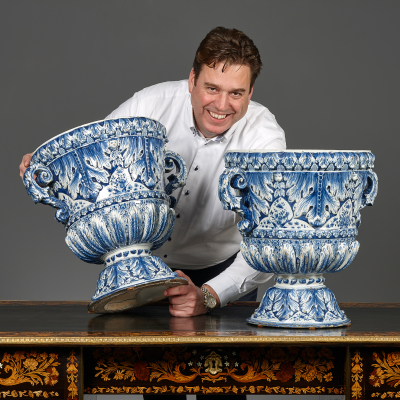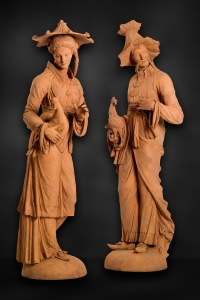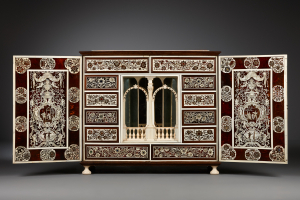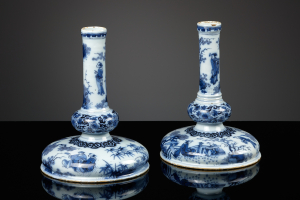Pair of blue and white Delftware garden vases
Pair of blue and white Delftware garden vases
A pair of large Delftware Medici-shaped garden vases, standing on a tall base that widens towards the bottom, which is decorated with dependent acanthus leaves in relief, interspersed with satyr’s heads with protruding tongues and, along the edges, with cartouches filled with fine floral patterns. The body of the vase is divided into wide horizontal bands. The wide central band features the same decorative scheme as the foot. Below it is a narrow ribbon of dependent shells, and below that is a band featuring dense floral decorations around upstanding leaves in deep relief. The S volute-shaped handles are rendered as elegantly curling leaves.
The foot and the body of the flaring basin were turned, while the middle section was made separately. The four components were then joined using clay paste, after which the whole would have been left to dry. The various leaves with relief surfaces that were used to decorate the vases were separately pressed in a mould, turned out at the leather-hard stage, and then affixed to the vase’s surface with clay paste. The turner, shaper and finisher must have spent many hours of work on these pieces. After shaping, firing and glazing, the vases were meticulously painted in accordance with the latest fashion.
Although they are unmarked, these items can be attributed with a high degree of certainty to the pottery De Metaale Pot, managed by Lambertus van Eenhoorn. A similar but polychromed pair can be found in Rijksmuseum’s collection (inv. BK-1961-98)
Lambertus van Eenhoorn (1651-1721)
After spending several years travelling during his military service and repeated attempts to study medicine, Lambertus van Eenhoorn ended up registered as a porcelain potter, like his father and brother, in 1689. In 1691, he took over the Delft-based pottery De Metaale Pot. His new role as a producer of plateel pottery suited him very well, and he soon became one of the most successful potters in Delft, with a reputation for innovative, refined designs.
Large garden vases had been produced in Delft since the 1680s by various potteries including De Grieksche A, De Metaale Pot, and Het Moriaanshooft. De Metaale Pot had the capacity to produce such garden vases in four different sizes in 1691, expanding to five sizes in 1724. Various documents reveal exactly what people at the time defined as garden vases, such as the orders placed in China by the Lords XVII of the Dutch East India Company. Their orders were accompanied by drawings and comments that the garden vases, ornaments for garden placement, were to be placed upon a base and fitted with handles, and that three holes in the bottom were required for water drainage.
Contemporary representations of garden vases can be found in tile tableaus and paintings. Such vases were placed in gardens and might hold small orange trees, for example, serving to decorate the edges of a patio or along paths. They could be placed on pedestals, though this was not obligatory. The fact that it was fashionable at the time to embellish gardens with such adornments is also clear from estate inventories.
Literature:
Jan Daniël van Dam, Delffse Porceleyne; Delfts aardewerk 1620-1850, Zwolle, 2004, p. 113-117
Marion S. van Aken-Fehmers en Loet A. Schledorn, Delfts aardewerk; geschiedenis van een nationaal product, deel II, Zwolle, 2001, p. 258-259
- Provenance
- Aveline Antiquités et Décoration, Paris, 1991
Krehbiel collection, Chicago - Period
- ca. 1700
- Material
- Delftware
- Dimensions
- 46 x 56 cm
- Diameter
- 40.00 cm
Global shipping available










